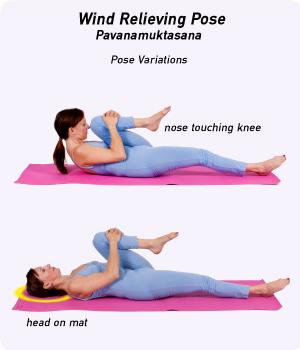How to Do Wind-Relieving Pose in Yoga

Wind-Relieving Pose — Pavanamuktasana (pah-van-ah-mook-TAHS-uh-nuh) — is a reclined yoga posture that is suitable for everyone, from beginners to advanced practitioners. The pose gently massages the abdominal organs, releasing tension in the belly area and low back. Its name comes from three Sanskrit words:
- “Pavana” — meaning “air” or “wind”
- “Mukta” — meaning “freedom” or “release”
- “Asana” — meaning “pose”
Pavanamuktasana helps with relieving excess digestive gas (“wind”) from the stomach and intestines. It is also sometimes referred to as, “One-Legged Knee-to-Chest Pose.”
Benefits of Wind-Relieving Pose
Pavanamuktasana, as its name states, is most useful for helping to release unwanted and toxic gases from the digestive system. The removal of this excess air helps to improve the quality and efficiency of your digestive system. It also relieves indigestion, bloating, flatulence, acidity, and constipation.
The body can feel completely at ease and natural every moment. Just let it.
This pose also helps to release tension in the lower back, hips, and thighs. It soothes stiffness in the spine, while toning the muscles of the abdominal wall.
Cautions
Do not practice this pose if you are recovering from abdominal surgery or a hernia. Also, avoid this pose if you have a spinal injury or sciatica. Pregnant women should also not practice this pose. Always work within your own range of limits and abilities. If you have any medical concerns, talk with your doctor before practicing yoga.
Instructions

- Begin by lying on your back, with your legs and arms extended.
- As you exhale, draw both of your knees to your chest. Clasp your hands around them.
- While holding only your right knee, release your left leg and extend it along the floor. Hold this pose for up to one minute.
- Draw your left knee back in towards your chest and clasp your hands around both knees again.
- While holding only your left knee, release your right leg and extend it along the floor. Hold this pose for the same amount of time.
- Finally, draw both knees to your chest.
- With an exhalation, release and extend both legs along the floor and rest.
Modifications & Variations
Wind-Relieving Pose is suitable for beginners. There should be no pain and very little discomfort when performed. If you need to modify the pose to make it more comfortable, try these simple changes to find a variation that works best for you:
- To deepen the stretch, bring your nose to your knee when you're in the full pose.
- If your stomach or chest is large, it might be difficult to clasp both hands around the leg that is drawn in. To remedy this, draw your knee slightly to the side of your body, toward your same-side armpit, instead of clasping it directly over your chest.
- If it is still difficult to clasp both hands around your knee, wrap a yoga strap around your knee and hold onto the strap with both hands.
- If your hips are very tight, bend the knee of your extended leg and place your foot flat on the floor, instead.
Tips
Practicing Pavanamuktasana can soothe and comfort abdominal distress and low back pain. Keep the following information in mind when practicing this pose:
- Always begin the sequence with your right knee drawn in and left leg extended. Your right leg and knee will place pressure on the ascending colon. When you change sides (left knee in, right leg extended), your left leg places pressure on the descending colon. This right-left order stimulates digestion and correctly releases excess “wind.” Reversing the sequence and pressing on the descending colon first can cause aggravation, constipation, bloating, and intestinal discomfort.
- Work to keep the extended leg as straight as possible, and keep the buttocks of the lifted leg drawing down toward the mat. Try not to let your lower back come off the floor at all.
Release to Rebalance
Relieving yourself of built-up pressure can be relaxing to your body, mind, and spirit. Pavanamuktasana is a gentle reminder of your body's ability to heal itself. Try a few rounds of this pose first thing in the morning, while you're still lying in bed. By softly waking your body in this way, you may notice a greater ease of movement throughout your day!

